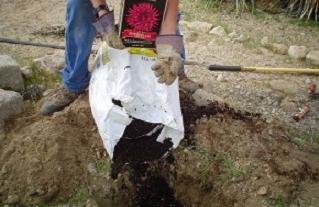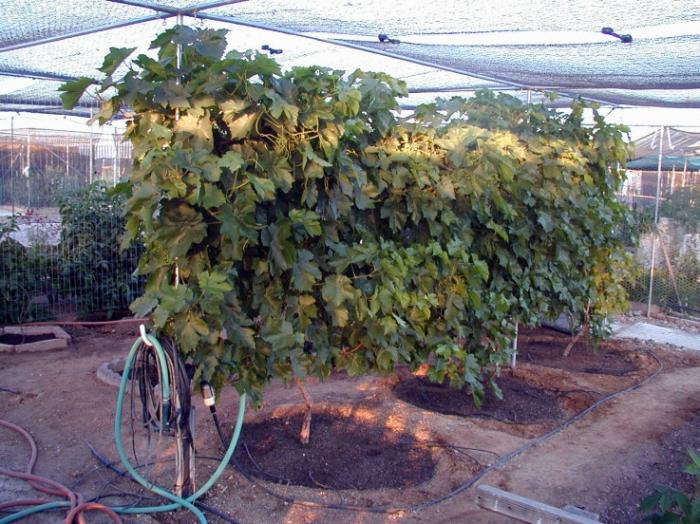
Питательные вещества (корневые подкормки grapes) under the bush to lay when planting. A spit of wood ash or 400 g of double superphosphate is poured onto the bottom of the landing pit, 80 cm in diameter and 80 cm deep, making 15 cm of grass compost. For the root system of a grape bush, two opposite conditions must be taken into account. First: the roots do not need to be buried more than 30-40 cm. Then they will warm up in time in spring and will not delay the development of the vine. Second: the roots should have a large supply of moisture, which is possible only at great depths. Therefore, for irrigation and application of liquid fertilizing of grapes, it is necessary to prepare this way: a ring is laid out of a special perforated drainage pipe with a diameter of 10 cm and a length of 2.5 m to the bottom of the pit. One end of the pipe is closed tightly. A plastic tube with a diameter of 10 cm and a length of 50-60 cm that goes to the surface of the earth is inserted into the other end. Drainage from a layer of coarse gravel, crushed stone or expanded clay 10 cm thick is arranged around the pipe. Twigs and slate fragments are laid on the drainage layer so that the drainage does not become covered with earth. The pipe is in a fabric cover, which prevents silting of holes with soil. The purpose of the complex drainage device is clear: watering and feeding the grapes will be brought to the deep roots, which stimulates the growth of the bush. The top "dewy" roots of the plant in the absence of irrigation from above will be weak, which will reduce the probability of weakening the plant in the winter. Also through the pipe will flow air over a large area. A layer of earth is poured into a hole of 20 cm and a sapling is placed on it. Fill the hole to the top with earth. It is important to straighten all the roots and send them in depth.

Correct watering
Grapes plentifully watered 2-3 times over the summer.The first time is at the beginning of the growing season before the budding of the eyes. It would be great if the first watering make melt water. The next abundant watering - before the beginning of the coloring of the berries. If the weather is too dry, then you can water well during the growth of berries. You can not water the grapes during the flowering period, it will cause the flowers to fall off. Stop watering for 3 weeks before harvest, so that the skin on the ripening berries do not burst from excessive moisture, and the vine has time to harden (mature). In the autumn, moisture-charging irrigation is carried out, wetting the soil abundantly and deeply. Watering combined with dressing.
Feeding grapes
If organic matter has been added to the grape seedlings andmineral fertilizers, the planting pit is filled with fertile soil, then for several years they will only need regular liquid dressings. From organic fertilizers: slurry solution, chicken manure solution, wood ash. Pre-mullein or chicken droppings are fermented for 10 days in a barrel, then the slurry is diluted with water at a ratio of 1:10 and the solution is poured into a drainage well, a bucket for each bush. This fertilizer containing nitrogen is used from spring to mid-summer.

Feeding the grapes with ash is held in spring andin the fall. In the spring, ash is introduced into the soil around the bush. It is necessary to make for this pits a depth of 20-30 cm, fill them with ash and cover with earth. Sprinkle the ground with plenty of ash and promulgate from above. For one adult bush enough 2 kg of ash. In the fall, when water-charging irrigation, 4 buckets of water are poured under the bush, and in the fifth they dissolve 300 g of ash and are poured under the grapes. Have a good foliar top dressing with ashes. To do this, dissolve the ash in water in a ratio of 1: 2 and leave for 2 days, stirring occasionally. The pooled water is drained, filtered and topped up with 2 volumes of water. Spray the leaves on both sides. This dressing will also protect against fungal diseases of the grapes. Mineral fertilizers are applied as a solution during irrigation and only in drainage wells. Spring top dressing: nitrogen 20 g, phosphorus 30 g and potassium 15 g per bucket of water under each bush. After the grapes are flowering and before the ripening of the grapes, mineral fertilizing of the grapes is made: 10 g of potassium salt, 145 g of ammonium nitrate and superphosphate 25 g are dissolved in a bucket of water, the solution is poured into the drainage tube. To feed the plant with calcium, lime supplementation is needed - 150 g per bush. In the autumn to bring into the soil to a depth of 20 cm, in the spring - to a depth of 5 cm.






























